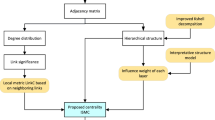Abstract
Actors in social networks tend to form community groups based on common location, interests, occupation, etc. Communities play special roles in the structure–function relationship; therefore, detecting such communities can be a way to describe and analyze such networks. However, the size of those networks has grown tremendously with the increase of computational power and data storage. While various methods have been developed to extract community structures, their computational cost or the difficulty to parallelize existing algorithms make partitioning real networks into communities a challenging problem. In this paper, we introduce a generative process to model the interactions between social network’s actors. Through unsupervised learning using expectation maximization, we derive an efficient and fast community detection algorithm based on Bayesian network and expectation maximization (BNEM). We show that BNEM algorithm can infer communities within directed or undirected networks, and within weighted or un-weighted networks. We also show that the algorithm is easy to parallelize. We then explore and analyze the result of the BNEM method. Finally, we conduct a comparative analysis with other well-known methods in the fields of community detection.











Similar content being viewed by others
Notes
A discrete distribution (Discrete (\(\theta\)))—generalized Bernoulli distribution—is a probability distribution that describes the result of a random event that can take on one of \(c\) possible outcomes, with the probability of each outcome separately specified with the vector parameter \(\theta\).
References
Adnan D (2009) Modeling and reasoning with Bayesian networks. Cambridge University Press, New York
Albert R, Barabasi A-L (2002) Statistical mechanics of complex networks. Rev Mod Phys 74(47–97):2002
Bastian M, Heymann S, Mathieu JG, et al (2009) Gephi: an open source software for exploring and manipulating networks. In: The International Conference on Weblogs and Social Media, vol 8, pp 361–362
Clauset A, Newman MEJ, Cristopher M (2004) Finding community structure in very large networks. Phys Rev E 70:066111
Condon A, Richard M (2001) Algorithms for graph partitioning on the planted partition model. Random Struct Algor 18:116–140
Cormen TH, Leiserson CE, Rivest RL, Stein C (2001) Introduction to Algorithms. MIT Press
Danon L, Diaz-Guilera A, Duch J, Arenas A (2005) Comparing community structure identification. J Stat Mech Theory Exp 9:09008
Dempster AP, Laird NM, Rubin DB (1977) Maximum likelihood from incomplete data via the em algorithm. J Royal Stat Soc Ser B 39:1–38
Duncan JW, Steven HS (1998) Collective dynamics of small-world networks. Nature 393(6684):440–442
Fortunato S (2010) Community detection in graphs. Phys Rep 486:75–174
Girvan M, Newman MEJ (2002) Community structure in social and biological networks. Proc Natl Acad Sci 99:7821–7826
Hastings MB (2006) Community detection as an inference problem. Phys Rev E 74(035102):2006
Hofman JM, Wiggins CH (2008) Bayesian approach to network modularity. Phys Rev Lett 100:258701
Hofman CH, Wiggins JM. VBMOD MATLAB. http://vbmod.sourceforge.net/. Accessed 2014
Jacomy M, Heymann S, Venturini T, Bastian M (2011) Forceatlas2, a graph layout algorithm for handy network visualization. Medialab center of research
Judea P (1998) Probabilistic reasoning in intelligent systems: networks of plausible inference. Morgan Kaufmann
Julian JM, Jure L (2012) Learning to discover social circles in ego networks. In: Advances in neural information processing systems, pp 548–556
Lancichinetti A, Fortunato S, Radicchi F (2008) Benchmark graphs for testing community detection algorithms. Phys Rev E 78(4):046110
Leskovec J. Social circles in ego networks. http://snap.stanford.edu/socialcircles/. Accessed 2014
Lusseau D (2003) The emergent properties of dolphin social network. Proc Royal Soc Lond Ser B Biol Sci 270:S186–S188
Mark N. Network DataSets. http://www.personal.umich.edu/mejn/netdata. Accessed 2014
Michael IJ, Zoubin G, Tommi SJ, Lawrence KS (1999) An introduction to variational methods for graphical models. Mach Learn 37:183–233
Newman M, Barabasi A-L, Duncan JW (2006) The structure and dynamics of networks. Princeton University Press, Princeton
Newman MEJ, Girvan M (2004) Finding and evaluating community structure in networks. Phys Rev E 69:026113
Newman MEJ, Leicht EA (2007) Mixture models and exploratory analysis in networks. Proc Natl Acad Sci 104:9564–9569
NodeXL. http://nodexl.codeplex.com/. Accessed 2014
Radicchi F, Castellano C, Cecconi F, Loreto V, Parisi D (2004) Defining and identifying communities in networks. Proc Natl Acad Sci USA 101:2658–2663
Steffen LL (1995) The em algorithm for graphical association models with missing data. Comput Stat Data Anal 19:191–201
Wakita K, Tsurumi T (2007) Finding community structure in mega-scale social networks. In: Proceedings of the 16th international conference on World Wide Web, pp 1275–1276, ACM
Zachary WW (1977) An information flow model for conflict and fission in small groups. J Anthropol Res 33:452–473
Author information
Authors and Affiliations
Corresponding author
Rights and permissions
About this article
Cite this article
Hafez, A.I., Hassanien, A.E. & Fahmy, A.A. BNEM: a fast community detection algorithm using generative models. Soc. Netw. Anal. Min. 4, 226 (2014). https://doi.org/10.1007/s13278-014-0226-0
Received:
Revised:
Accepted:
Published:
DOI: https://doi.org/10.1007/s13278-014-0226-0




